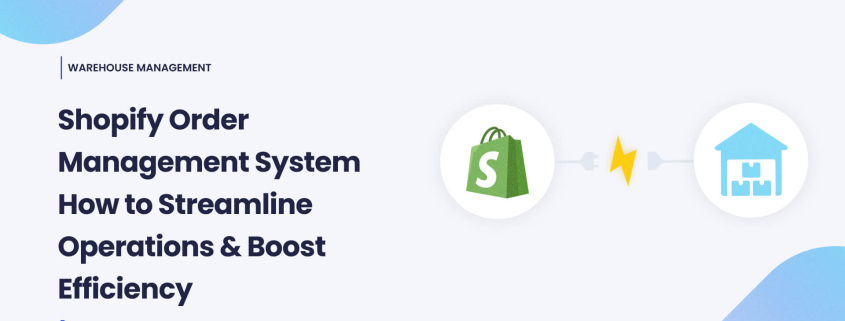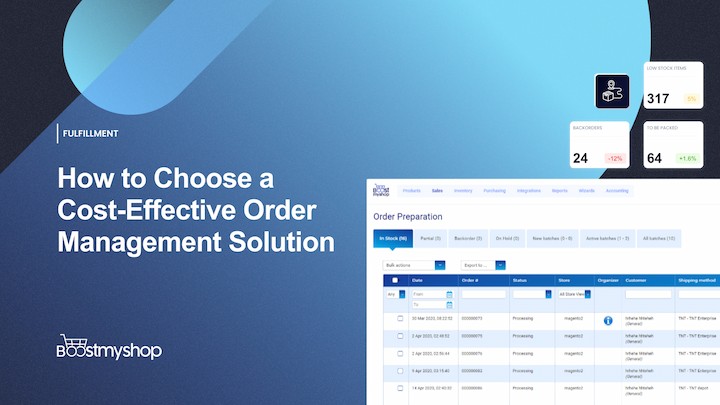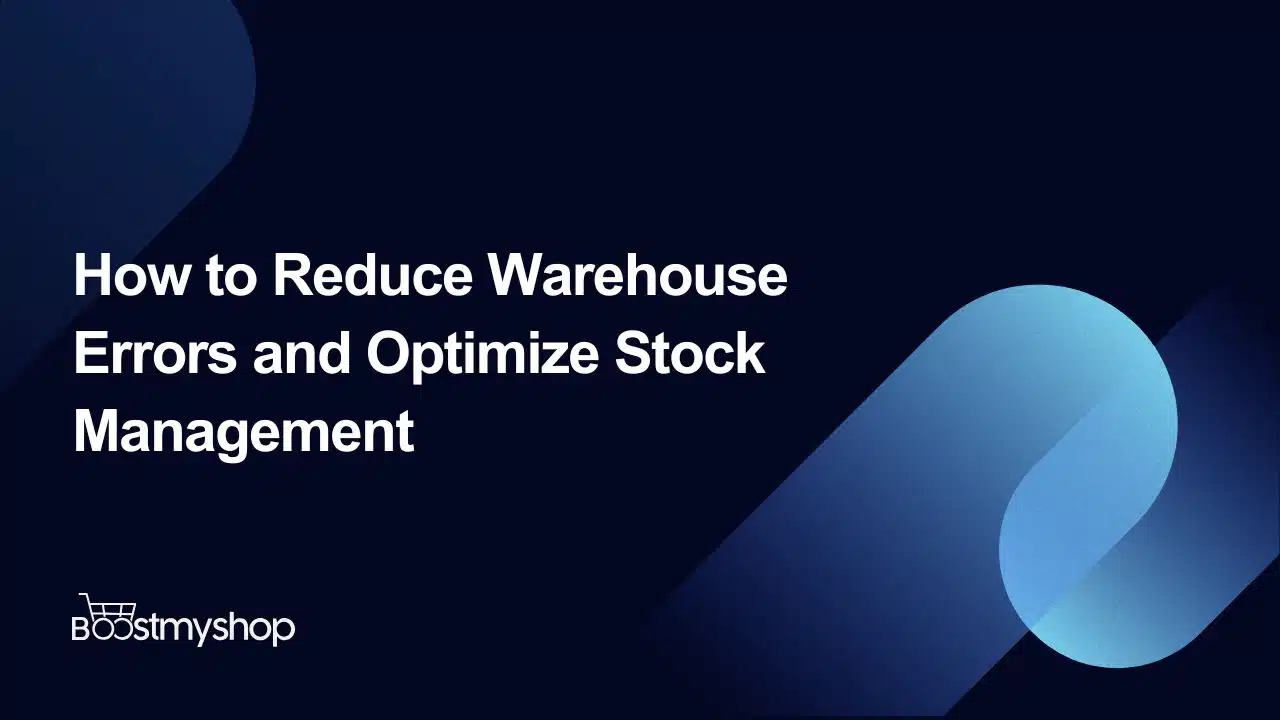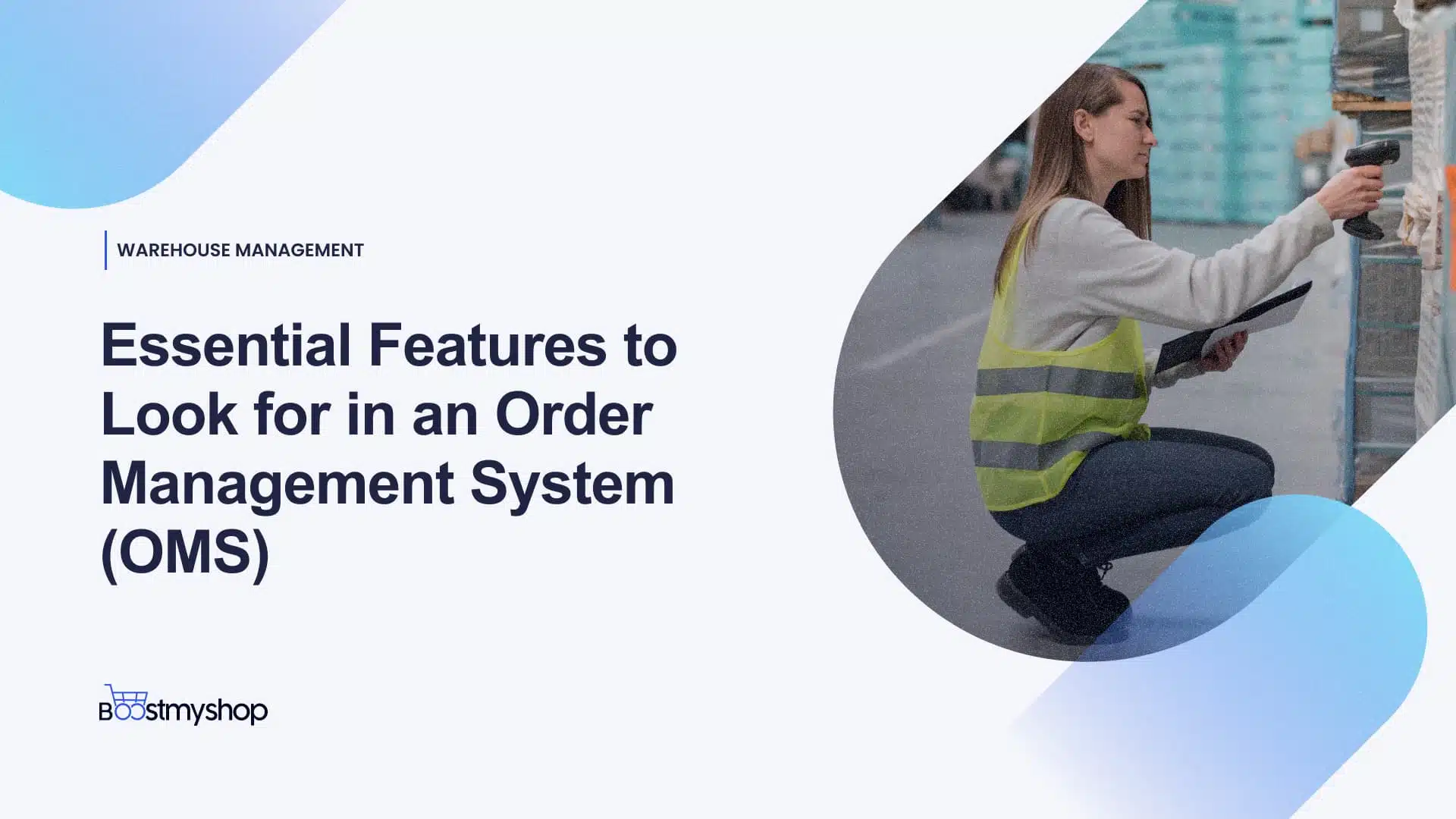Shopify Order Management System: How to Streamline Operations & Boost Efficiency
Introduction
Being a Shopify merchant is more than just attracting customers and generating sales, it’s about fulfilling orders efficiently and ensuring a seamless shopping experience. Yet, many Shopify merchants struggle with inventory mismanagement, delayed shipping, and errors in order processing, leading to lost sales and dissatisfied customers.
The Challenges of Managing Orders on Shopify
As your Shopify store scales, handling orders manually or relying solely on Shopify’s native tools can become overwhelming. Some common challenges include:
- Stockouts and Overselling: Inaccurate inventory tracking leads to canceled orders and frustrated customers.
- Slow, Manual Order Processing: Time-consuming fulfillment processes increase shipping delays.
- Multi-Channel Complexity: Selling on multiple platforms (Amazon, eBay, social media) without a centralized system results in fulfillment chaos.
- Return & Refund Bottlenecks: Managing returns manually can create inefficiencies that impact customer loyalty.
Managing Multiple Shopify Stores Across Different Currencies
When selling in multiple countries or currencies, Shopify recommends creating a separate store for each region to manage billing, taxes, and currency discrepancies. While this is a smart move operationally, it can quickly escalate costs for merchants, especially when dealing with external integrations such as Warehouse Management Systems (WMS).
Many WMS solutions charge merchants high fees based on the number of Shopify stores they connect, which can add up quickly if you’re managing multiple stores for different countries or currencies.
At Boostmyshop, we understand this challenge. Unlike other WMS providers, we offer an affordable and streamlined solution; myFulfillment that supports multiple Shopify stores under a single, unified package. This means you can manage all your stores, regardless of the number or currency, at a much more cost-effective rate while maintaining operational efficiency.
The Cost of Inefficiency
Poor order management doesn’t just affect internal workflows-it directly impacts revenue and customer satisfaction. Studies show that:
- 34% of businesses ship late orders due to inefficient management.
- 20% of customers abandon future purchases after a poor fulfillment experience.
- Overselling and stockouts lead to customer churn and negative brand perception.
Why an Advanced OMS is the Key to Scaling Your Shopify Store
To scale successfully, Shopify merchants need an Order Management System (OMS) that eliminates inefficiencies, synchronizes inventory in real time, and automates fulfillment.
MyFulfillment: The All-in-One Shopify Order Management Solution
MyFulfillment is designed to help Shopify merchants streamline their entire order fulfillment process-from inventory tracking to multi-channel integration. With automated order processing, real-time stock updates, and seamless warehouse synchronization, MyFulfillment ensures that your business runs smoothly without manual bottlenecks.
- Automate Order Processing – Say goodbye to manual tasks and reduce fulfillment errors.
- Real-Time Inventory Synchronization – Keep stock levels updated across Shopify, Amazon, eBay, and more.
- Centralized Dashboard – Manage all sales channels, warehouses, and shipping partners from one platform.
- Smart Stock Allocation – Ensure the right inventory is available where it’s needed most.
Understanding Shopify Order Management
Shopify provides a built-in order management system that allows merchants to handle basic fulfillment tasks. From the Shopify dashboard, store owners can:
- View and track orders – Monitor new, pending, and fulfilled orders in a centralized dashboard.
- Update order statuses – Mark orders as paid, fulfilled, or refunded.
- Manage inventory – Track stock levels for individual products.
- Generate invoices and shipping labels – Print packing slips and connect with supported carriers for shipping.
While these native tools work well for small businesses with low order volumes, scaling merchants often find them inadequate as their operations grow.
Limitations of Shopify’s Built-in Order Management Tools
Lack of Real-Time Inventory Synchronization
○Shopify’s native inventory system does not automatically sync stock levels across multiple warehouses, stores, and sales channels.
○This can result in overselling, where customers purchase out-of-stock items, leading to canceled orders and refunds.
Manual Order Processing Leads to Delays
○Merchants often need to manually confirm, print, and fulfill orders, which slows down the process.
○High order volumes can create backlogs, leading to slower shipping and poor customer experiences.
Limited Multi-Channel Capabilities
- Shopify does not offer seamless integration with third-party marketplaces like Amazon, eBay, or social commerce platforms without additional apps.
- Managing orders across multiple channels requires juggling multiple systems, increasing complexity.
Returns & Refunds are Not Fully Automated
- Handling returns manually takes up time and resources.
- Shopify’s default system lacks advanced return automation, making it difficult to streamline reverse logistics.
Key Considerations When Choosing an Advanced OMS
For Shopify merchants looking to scale, an advanced Order Management System (OMS) is essential. Here’s what to look for:
- Automation & Efficiency – The OMS should automate order routing, stock updates, and fulfillment tasks to reduce manual effort.
- Real-Time Inventory Synchronization – A good system syncs stock across Shopify, warehouses, and external marketplaces in real-time.
- Multi-Channel Order Management – Seamless integration with Amazon, eBay, and other sales channels ensures all orders are managed from one place.
- Returns & Refund Automation – Smart systems should automate return processing and customer refunds to reduce manual work.
- Scalability – The OMS should grow with your business, handling thousands of orders without slowdowns.
A solution like MyFulfillment provides all these features, helping Shopify merchants streamline their operations effortlessly.
Common Order Management Challenges for Shopify Merchants
As Shopify stores grow, they face increasing complexities in handling orders, stock, and fulfillment. Here are some of the most common pain points:
Overselling & Stockouts – Lost Sales Due to Inventory Mismanagement
When inventory isn’t updated in real time, Shopify merchants run the risk of:
- Selling out-of-stock items, leading to canceled orders.
- Frustrating customers with backorders and refunds.
- Losing revenue due to poor stock planning.
Data Insight: According to a Retail Dive study, out-of-stock products cause retailers to lose an estimated $1 trillion annually in missed sales (In U.S Alone).
Solution: Shopify merchants need an OMS that synchronizes stock across all channels in real time, ensuring inventory accuracy.
Manual Processing & Errors – The Cost of Inefficiency
Processing orders manually may work for small stores, but as order volumes increase, merchants face:
- Human errors in address entry, order confirmation, and fulfillment.
- Slower processing times leading to shipping delays.
- Increased operational costs due to inefficiencies.
Solution: Automating order processing with smart workflows and automated fulfillment rules reduces errors and speeds up operations.
Multi-Channel Complexity – Managing Shopify, Marketplaces & Offline Sales
Expanding beyond Shopify to Amazon, eBay and physical stores etc means merchants must manage orders from multiple platforms. The challenges include:
- Orders coming from different sales channels but being processed separately.
- Inventory not syncing properly, leading to inconsistent stock levels across platforms.
- Increased admin work, requiring merchants to switch between dashboards.
Solution: A multi-channel OMS unifies Shopify with external marketplaces, centralizing all orders in one platform for seamless processing.
Delayed Fulfillment & Returns – Impact on Customer Satisfaction & Retention
Today’s customers expect fast, hassle-free shipping and easy returns. Poor order management leads to:
- Shipping delays, increasing customer frustration.
- Complicated return processes, making refunds slow and inefficient.
- Lost repeat customers due to negative experiences.
Stat: A study by Narvar found that 96% of consumers will shop with a retailer again if the return process is smooth and hassle-free.
Solution: Implementing an advanced OMS with automated returns processing ensures faster refunds and higher customer retention.
How MyFulfillment Solves These Challenges for Shopify Merchants
MyFulfillment helps Shopify merchants eliminate inefficiencies, sync inventory across channels, and automate order processing.
Real-Time Stock Updates – Prevent overselling and stockouts. Automated Order Fulfillment – Speed up processing and reduce errors. Seamless Multi-Channel Integration – Unify Shopify, Amazon, eBay, and more. Smart Returns Management – Improve customer experience with fast refunds.
Key Features to Look for in a Shopify Order Management System
Seamless Integration with Shopify A reliable order management system (OMS) must integrate smoothly with your Shopify store. With a seamless connection, order details, customer information, inventory updates, and shipping statuses sync in real-time, providing a hassle-free experience for both merchants and customers.
Centralized Dashboard A unified dashboard is essential for effective order management. It allows you to manage all aspects of your e-commerce business in one place-orders, inventory, and fulfillment. This feature helps merchants streamline operations, easily track the status of orders, and monitor inventory levels in real-time.
Automated Order Routing To optimize the fulfillment process, automated order routing assigns orders to the best fulfillment center based on location, stock availability, and other criteria. By ensuring that orders are directed to the nearest warehouse or store with sufficient inventory, businesses can reduce shipping time, lower costs, and improve delivery speed.
Shipping & Carrier Integration Integrating with logistics and carrier partners is crucial for timely order fulfillment. A robust Shopify OMS connects with various shipping carriers, automating the process of selecting the best shipping option for each order. This integration ensures faster delivery times, real-time tracking updates for customers, and cost-effective shipping solutions.
Scalability As your business grows, so do your order management needs. A scalable Shopify OMS can handle increased order volumes without causing delays or operational bottlenecks. A system built for growth ensures that your e-commerce operations remain smooth as you scale.
How MyFulfillment Enhances Shopify Order Management
Faster Order Processing MyFulfillment speeds up the entire order process by automating repetitive tasks and streamlining workflows. With features like automated stock updates, order confirmations, and shipment tracking, your team can focus on more strategic tasks while the system handles routine processes.
Smart Inventory Management MyFulfillment offers intelligent inventory management to prevent stockouts and overstocking. With smart alerts and automatic restocking suggestions, MyFulfillment helps ensure you maintain optimal stock levels, reducing the risk of missed sales or excess inventory.
Omnichannel Synchronization With MyFulfillment, your Shopify store is fully synchronized with your physical stores, marketplaces, and warehouses. This omnichannel approach ensures consistency across all platforms and provides customers with a seamless shopping experience, whether they buy online or in-store.
Error-Free Fulfillment By automating and streamlining your fulfillment process, MyFulfillment reduces the risk of human error. The system ensures that the right products are picked, packed, and shipped, minimizing shipping mistakes and returns. This leads to improved customer satisfaction and trust, as orders are delivered accurately and on time.
Data-Driven Decision Making MyFulfillment provides valuable insights through comprehensive reporting. Merchants can analyze order trends, sales performance, and inventory health to make data-driven decisions. By using these insights, businesses can optimize their operations, identify areas for improvement, and adjust their strategies to better meet customer demands and drive growth.
Actionable Steps to Optimize Order Management Today
Audit Your Current Process The first step to optimizing your order management system is performing a thorough audit of your current processes. Identify bottlenecks and inefficiencies that slow down your order fulfillment and impact customer satisfaction. Evaluate each stage of the process-from order receipt to shipping-and pinpoint where improvements can be made. By understanding your current pain points, you’ll be better positioned to make targeted improvements.
Automate Where Possible Manual processes often lead to errors, delays, and wasted time. Take advantage of automation tools that can streamline your order management workflows. From automated inventory updates to order routing and shipping label creation, implementing automation reduces human error and accelerates the process. The less manual intervention required, the faster and more accurate your operations will become, allowing you to scale with ease.
Leverage Data & Analytics In today’s competitive e-commerce landscape, data is your best ally. Use data and analytics to uncover insights that can refine your fulfillment strategies. Analyze order trends, inventory levels, customer preferences, and shipping performance to make informed decisions. By leveraging data-driven insights, you can predict demand more accurately, optimize stock levels, and improve fulfillment efficiency. This helps you stay ahead of the competition and better serve your customers.
Choose the Right OMS Selecting the right order management system (OMS) is key to improving your operations. When evaluating an OMS, look for a solution that integrates seamlessly with your Shopify store, offers automation features, and provides comprehensive reporting tools. Consider the scalability of the system to ensure it can grow with your business and meet your evolving needs. Additionally, look for a system that offers omnichannel support, enabling you to manage orders from your website, marketplaces, and physical stores all in one place.
Scale Smarter with the Right Order Management System
Recap of Key Takeaways Optimizing your order management system is crucial for scaling your e-commerce business efficiently. Key steps include auditing your current process, automating repetitive tasks, leveraging data for smarter decisions, and choosing the right OMS that can grow with your business. These actions will streamline your fulfillment workflows, improve customer satisfaction, and position your brand for long-term success.
Why MyFulfillment is the Ideal Solution for Shopify Merchants For Shopify merchants looking to optimize their order management, MyFulfillment offers the perfect solution. With its seamless integration, smart automation, and real-time inventory tracking, MyFulfillment ensures faster, error-free order processing. Plus, its omnichannel synchronization and data-driven insights allow you to make informed decisions and scale your operations with confidence. Whether you’re a small startup or a growing enterprise, MyFulfillment supports your business every step of the way.






